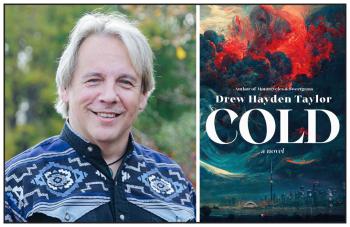Image Caption
Summary
Local Journalism Initiative Reporter
Windspeaker.com
How do the lives of an Indigenous professor and an aging hockey player in the Indigenous Hockey League intersect with an investigation being carried out by a Toronto detective? It’s all because of an Indigenous myth terrorizing the largest city in Canada.
That’s the premise of Ojibway author Drew Hayden Taylor’s newest novel Cold, to be released this week by McClelland & Stewart.
That Taylor dives into the realm of horror is no surprise. His first novel was about vampires and he’s tackled the subjects of magic realism and science fiction.
In Cold, one of Taylor’s main characters is residential school survivor and university professor Elmore Trent. Trent’s speciality is Indigenous Studies.
Through Trent, Taylor examines the place Indigenous legends play in today’s society, as well as why more Indigenous writers are embracing genres like science fiction and futurism.
“Usually,” reflects Trent in Cold, “Indigenous literature looked backwards—at what they had lost, were trying to get back or maintain.”
But it’s different now, says Taylor, with Indigenous writers flipping that lens and looking forward, which has led to an “explosion of Indigenous science fiction.”
“I just think Native people are now in a position where we have looked at where we came from and now we want to look at where we're going,” he said.
He adds that Indigenous writers are enjoying the freedom and the challenge of telling their stories and expressing themselves through different genres.
Looking to the future, he insists, doesn’t mean turning away from Indigenous myths or legends.
“Our legends are a combination of storytelling, of philosophy, of history, of psychology, et cetera,” said Taylor. “They’re just as important today as they always were.”
He also points out that legends are not just for children. Legends geared to adults “talk about the flaws of human nature. I think we still have flaws that need to be exposed and I think there's still a place for legends and storytelling in today's society.”
Cold embraces two legends, neither of which Windspeaker.com will reveal as both are integral to the plot. Both legends are told among the Anishnawbe and Cree, and Taylor embraces aspects from both for his novel. However, with one of those legends he undertakes “the biggest departure” to further his plot.
Cold is a work that Taylor originally conceived 20 to 25 years ago, but as a movie script. It never took off then.
“Writing a movie is such a specific and unique structure and talent and perhaps I didn't have the understanding of it then. I didn't really understand the format,” he said.
He also thought it would be too expensive to produce. But in the end, he said, “I don't think I had the drive to try and sell it.”
Fast forward a couple of decades and Taylor was looking for a new novel to write and remembered the script for Cold was on his shelf. He liked the characters and the story so returned to it.
“I sat down and began working on it and it flowed. It was quite fun and quite interesting and I just had so much fun writing it,” he said.
The narrative is told informally and includes a fair amount of dialogue. That approach, says Taylor, is in keeping with his other writing credits which include being a playwright and columnist, both of which are “very conversational.”
“A lot of my writing is from a personal, colloquial perspective, and I think that does bleed into my prose quite a bit,” he said.
Being a playwright, a fiction writer, television and film script writer, and columnist all offer their own attractions, says Taylor, from the instantaneous response of a live audience at a play to “short and sweet” and to the point in a column.
“With prose (fiction writing), you get to explore something really long term. It's just you, your thoughts and a laptop,” said Taylor.
The final sentence in the novel may leave readers wondering about what could come next.
“I'm a firm believer…as a writer…(that) once you, as the writer, write the end, it's up to the reader to decide what the story means. I'm a firm believer that as a writer, when people deconstruct our work, a third of it is planned and specific. One-third is maybe unconsciously inspired. And a third is just completely accidental. And I'm confident enough to say that,” said Taylor, who is from Curve Lake First Nation in central Ontario.
Whatever the reader’s interpretation of the ending may be, there is more to come.
The publishing company was so impressed by Cold that Taylor has been asked to write a sequel, something he plans to tackle this summer. They want him to focus on what they view as the “Indigenous X-files” team of Trent and Otter Lake Muskrats hockey player Paul North.
The problem, says Taylor, is that he’s “grown very, very fond” of two other Cold characters as well.
“And…it's kind of hard to work four people into a sequel where none of them are really connected other than through this particular incident. So I'm trying to find a way that I can bring everybody, or at least one of them, back to work with the other two. So that's part of the journey,” he said,
Taylor is undertaking a limited tour for Cold and will be in Ottawa, Toronto, Peterborough, Winnipeg and Vancouver.
Cold can be purchased in bookstores or online at https://www.amazon.ca/Cold-Novel-Drew-Hayden-Taylor/dp/0771002890
Support Independent Journalism! SUPPORT US!

